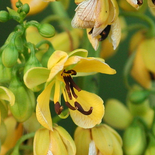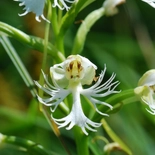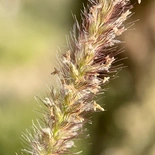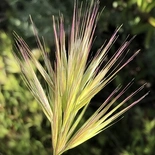To further Wild Ones’ mission to connect people and native plants, we are excited to continue a new monthly blog focused on native plants in national news. This regular feature aims to educate, engage, and inspire action by spotlighting conservation issues and scientific findings related to native flora.
Finding the Needle in the Haystack: Rare plant rediscovered in Wisconsin
Not seen since 1911, Maryland Senna (Senna marilandica) was discovered last summer in Wisconsin by George Riggin, a trained volunteer for the Department of Natural Resources’s Rare Plant Monitoring Program, and Bridget Rathman, a Department of Natural Resources (DNR) habitat biologist. This discovery was reported in the DNR’s Rare Plant Monitoring Program’s 2023 Annual Report. Out of Wisconsin’s 2,366 native plants, 15% of these species are listed as endangered, threatened, or listed as a species of special concern. In order to keep track of these rare species, the DNR runs a Rare Plant Monitoring Program, running almost entirely on volunteers. Jessica Ross, a DNR botanist, said that 52 volunteers submitted 178 rare plant reports including 31 populations in new locations in 2023, alone.

Maryland Senna(Senna marilandica)

Prairie Lespedeza(Lespedeza leptostachya)

Prairie White Fringed Orchid(Platanthera leucophaea)
Along with Maryland Senna, other rare plants found included the threatened prairie bush clover (Lespedeza leptostachya), eastern prairie fringed orchid (Platanthera leucophaea) in Winnebago County, and yellow water-lily (Nuphar lutea) in southwestern Wisconsin along the Galena River. Since 2013, 541 volunteers have trained under the DNR’s Rare Plant Monitoring Program and more volunteers are sought after to help the program find and document Wisconsin’s rare native plant populations.
Volunteers are the backbone of the Wisconsin DNR’s rare plant monitoring program -Milwaukee Journal Sentinel
Arizona: Wildfire and Invasive Species Threaten Saguaro Populations
More than 14,000 acres of Tonto National Forest is burning, a growing occurrence expected to become even more common as the climate continues to get hotter and drier. Unfortunately, plants like the saguaro have been unable to adapt to these rapidly changing conditions, says Challie Facemire with the Desert Botanical Garden. A study by the United States Forest Service found high mortality and stunted growth in the saguaro (Carnegiea gigantea) after high severity wildfires and that more than 30% of saguaro that hadn’t been killed during the wildlife, died within 10 years due to fire damage, disease, and other problems. The study urged fire prevention and suppression to save the saguaro.

Saguaro(Carnegiea gigantea)

Buffelgrass(Pennisetum ciliare)

Compact Brome(Bromus madritensis)

Stinknet(Oncosiphon piluliferum)
The loss of native species, like saguaro, have provided opportunities for invasive species such as buffelgrass (Cenchrus ciliaris), red brome (Bromus madritensis), and stinknet (Oncosiphon piluliferum) to spread. This perpetuates the wildfire impact to these desert ecosystems because without the native desert plants that usually slow the spread of fire, fires will burn faster and hotter as they burn through the invasive species populations and makes it harder for native plants to survive wildfire events. The community can volunteer to find and remove invasive species by joining the “Desert Defenders”, a community science program affiliated with the Desert Botanical Garden.
Saguaros and native plants threatened by wildfires and invasive species -Arizona ABC15
Pennsylvania: Creating Native Habitat in the City
The Philadelphia County Penn State Extension Master Watershed Steward program and the Friends of Wharton Square Park received the Governor’s Award for Environmental Excellence from the Pennsylvania Department of Environmental Protection for creating eight native plant habitat gardens in Wharton Square Park, the only city park in the Point Breeze section of South Philadelphia. During the community event, “Plant the Park” in June 2023, volunteers prepped the sites with mulch and compost provided by the City of Philadelphia, water that was provided by Vicinity Energy, and planted 16 native plant species provided by Xerces Society for Invertebrate Conservation. These gardens now provide habitat for wildlife and pollinators, support the local urban ecosystem, promote environmental education, and contribute to the park’s beauty and residential health. According to Department of Environmental Protection Interim Acting Secretary, Jessica Shirley: “This year’s Environmental Excellence honorees showcase the innovative ways we can protect our environment and shape a more sustainable future here in Pennsylvania. Together we will spur the next generation of environmental stewards, and these projects represent our ability to work together and preserve Pennsylvania’s natural resources”.
Penn State Extension praised by state for native plant gardens in Philadelphia -PSU.edu
Ohio: Planting the Native Seeds of Education
This April, the Cuyahoga Soil & Water Conservation District hosted a “Native Plants are Awesome” competition in honor of National Native Plant Month: two of the winning finalists were Harrison and Horace Mann elementary schools in Lakewood, Ohio. These schools will receive 50 native plants next fall to install in a garden. Harrison Elementary School plans to create a friendship garden with their native plants that the students will help design. That includes a sign with “Welcome” in English, a salute to many students that attend this school with native languages including Karen, Arabic, Dari/Persian, Sudanese, Turkish, and Nepali. Horace Mann Elementary entered the contest in hopes of giving Girl Scout troops a friendship garden to maintain after having no resources or gardens to tend previously. Parent Teacher Association member, Babette Gowda, said it was an opportunity for kids to learn about native plants and that the students are so excited that they have already started planting seeds. The Cuyahoga Soil & Water promotes native plants through competitions and through annual plant, seed, tree, and shrub sales hoping to instill community appreciation for native plants and their importance to wildlife habitats, hardiness, and environmental conservation.
Lakewood elementary schools plant seeds of conservation education -Cleveland.com
Michigan: Restoring Rare Wetland Habitat
The Nature Conservancy’s Erie Marsh Preserve, a rare Great Lakes coastal wetland, was part of a 12-year, $7.5 million habitat restoration that involved repairing levees, creating a new water management system creating a fish passage structure that reconnects the marsh to Lake Erie, and building 9.5 miles of hiking trails. The Erie Marsh Preserve is located on Lake Erie’s North Maumee Bay and is home to threatened plants such as the American lotus (Nelumbo lutea) and swamp rose-mallow (Hibiscus moscheutos).
Ecologically important Erie Marsh fills several crucial roles: habitat to many species, flood and erosion control, and improving water quality. Less than 5% of Michigan’s important coastal wetlands remain today. Since the restoration work began, an increase in waterfowl, shorebirds, raptors, and songbirds has been observed. Visitors are encouraged to use iNaturalist and eBird apps to identify and share sightings of plants and other wildlife so researchers and restoration managers can keep track of which species are calling Erie Marsh home.
Restored 2,200-acre Michigan preserve features rare plants, birds, 9 miles of trail -MLive.com
California: Restoration of All Things Native
A $900,000 Environmental Protection Agency grant is funding an Indigenous community garden and gathering place at California State University East Bay’s satellite campus in Concord. Soil, water, and air pollution will be monitored at the site and comparisons of habitat change after four years of restoration will be investigated regarding how climate adaptation is addressed. The grant will also help bridge the gap by working the land to provide fresh food for the community and improve the ecosystem on campus for wildlife and students. The land on which the community garden resides is at the base of Mount Diablo–Tuushtak in Chochenyo– which was home to Indigenous peoples including the Ohlone and Bay Miwok tribes for over 30,000 years. Wolwonja, the name of the garden, means “mountain” in the language of the Bay Miwok. The garden project began in 2022 with a $50,000 grant from the National Association of Conservation Districts. Kathy Cutting, Concord Campus’ administrative support coordinator, worked with Indigenous partners on the garden design. This included Vincent Medina and Louis Trevino, co-owners of Cafe Ohlone on campus, an Indigenous restaurant dedicated to the authentic culinary traditions of the Ohlone who will use items from this garden in these dishes. A plant list, approved by elders, was provided. Plant identification tags at the garden will have the scientific, English, and Chochenyo names. Visitors will be able to scan QR codes to hear the Chochenyo names and stories about the plant’s significance to the Ohlone life. Most plants will be edible and will be available to local Indigenous communities for ceremonies, crafts, and revitalizing their way of life. The space will showcase to the public how to sustainably grow native foods and medicinal plants.
U.S Environmental Protection Agency to visit Concord Center -CalState East Bay
Congongrass: The Southern Kudzu
An invasive grass species infestation is sweeping the south and working its way north. In Louisiana, Florida, Texas, Mississippi, Georgia, North Carolina, and Alabama, congongrass (Imperata cylindrica) is spreading.

Cogongrass(Imperata cylindrica)
Congongrass has hundreds of dense root systems that grow deep and sideways. The roots form dense mats and crowd out other plants. Each congongrass plant produces up to 3,000 seeds a year and those seeds are spread by wind, animals, and humans. Control is difficult: few wildlife eat congongrass because of the scratchy texture, mowing spreads the seeds, and fire doesn’t damage the roots. According to Kevin Craft with the Mississippi Forestry Commission, the best way to remove congongrass is with herbicides with imazapyr base and glyphosate base but it’s not a one-day job. Congongrass arrived from Asia to Louisiana accidentally in 1911 and then released intentionally in Florida in the 1930s. Congongrass can be identified by its feathery, white seed pot and off-centered vein on the grass leaves.
‘Aggressive, insidious and volatile’: Invasive grass causing problems, putting other plants at risk -WLBT3

